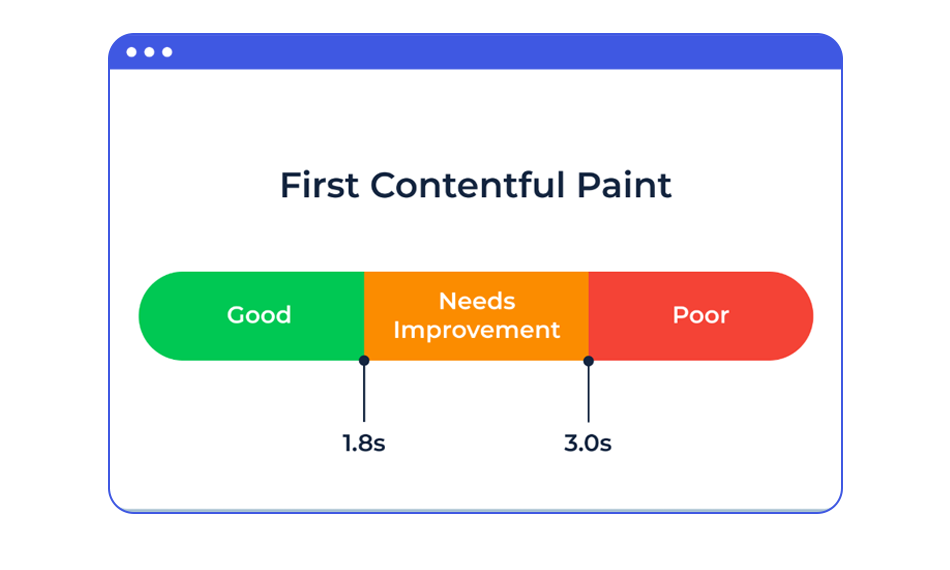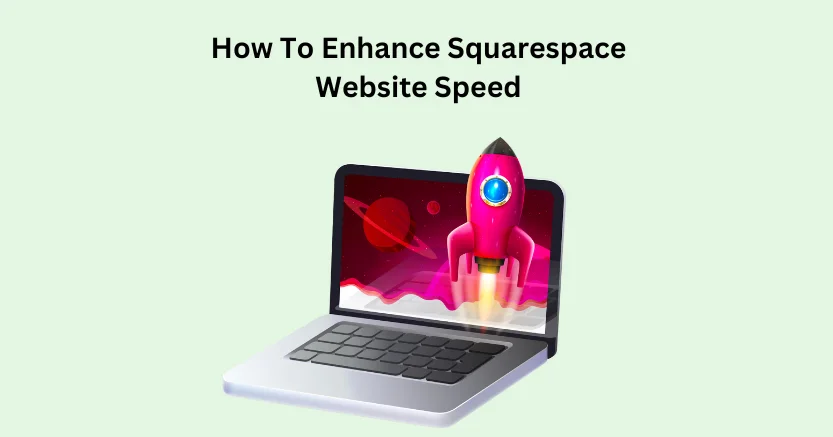TL;DR: First Contentful Paint (FCP) measures the time that your first piece of content takes to load when a user approaches your site. A good FCP score should ideally be less than 1.8 seconds. Know everything about the important metrics of core web vitals and learn to measure your site’s FCP score. Improve your score and enhance your SEO and UX.
How long does it take something to appear on the screen after you click on a website’s link? This waiting time is the First Contentful Paint. FCP is the time it takes for the first piece of text, image, or logo to appear on the screen.
It has a big impact on the user experience as it’s the very first impression of your site on the user. Google considers it a part of its Core Web Vitals as it impacts both user experience and SEO performance.
In this guide, we have covered every possible aspect of First Contentful Paint (FCP), including the best ways to enhance it for better rankings of your website
What is the First Contentful Paint (FCP)?
First Contentful Paint (FCP) is a Core Web Vitals metric introduced by Google in 2017. It measures the time a browser takes to show the first piece of valuable content on the screen after a user. This content could include text, pictures, a banner, or anything other than a non-white canvas.
For a good user experience, you should focus on a First Contentful Paint load score under 1.8 seconds. A longer FCP rendering time could increase bounce rates and cause a bad user experience.
What Is The Importance Of First Contentful Paint (FCP) For UX And SEO?
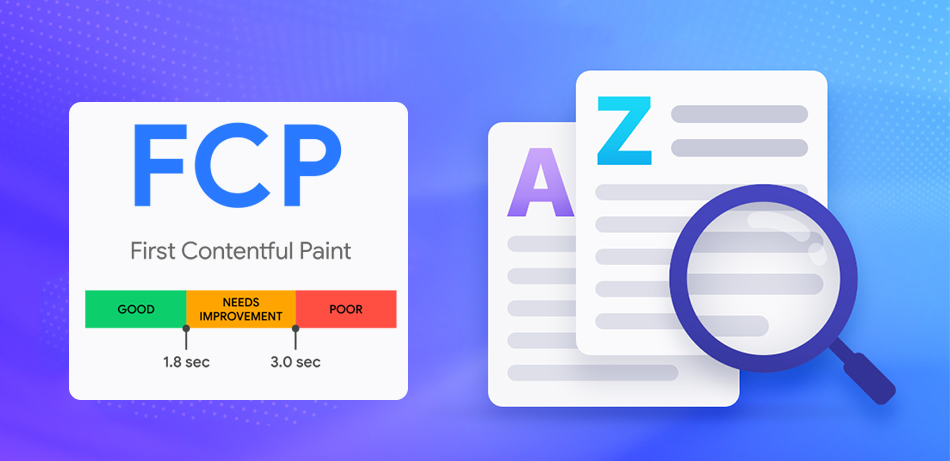
FCP is an important metric because it has a direct effect on both user experience (UX) and search engine rankings of your site.
User Experience (UX):
FCP has a direct impact on user experience, as your site will feel more responsive and trustworthy if the First Contentful Paint loading time is fast.
When someone clicks on a link, they expect to get a response right away. If your page takes too long to show any signs of loading, users might leave or lose trust in your site.
SEO and Rankings:
Google has revealed that user experience, page speed, and Core Web Vitals like FCP do affect SEO rankings. A bad FCP can hurt your rankings because it indicates to search engines that your site is slow and difficult to navigate for the user.
How to Measure First Contentful Paint (FCP)
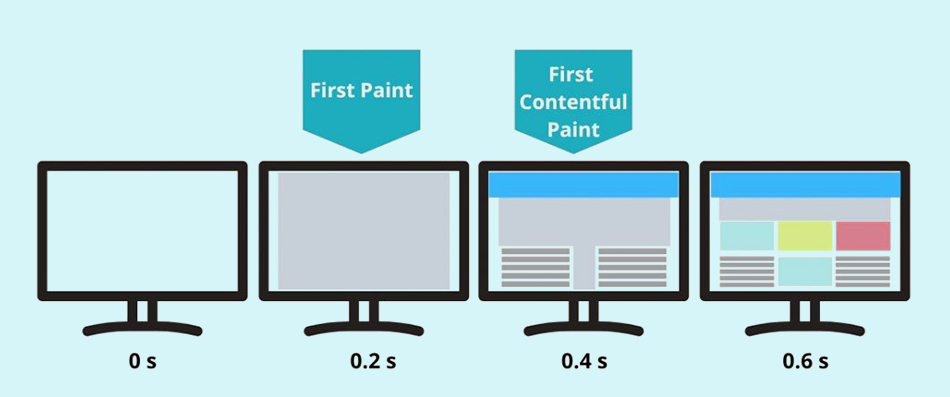
You should first measure your FCP before optimizing your website for enhancing the Core Web Vitals score. You can use several different tools to track your First Contentful Paint score:
1. PageSpeed Insights (PSI) from Google:
This tool leverages field and lab data to measure your FCP and LCP scores. Follow the steps to check scores in PageSpeed Insights:
Step 1: Type in your URL and click ‘Analyze’.
Step 2: Scroll to the Metrics section to see your First Contentful Paint (FCP)time.
Step 3: Check score ranges. 1.8s or Less indicates a good score. A Range of 1.8 to 3.0 seconds means you need improvements. An FCP score above 3.0 seconds indicates a poor First Contentful Paint score.
Step 4: Get the tips to improve your score in the ‘Opportunities and Diagnostics’ section.
2. Lighthouse (Chrome DevTools):
Lighthouse provides you with lab data on performance metrics and useful tips for making things better.
Step 1: Open a site in Google Chrome that you want to analyze.
Step 2: Right-click on the page and inspect (or press Ctrl+Shift+I).
Step 3: Go to the Lighthouse tab and select Performance, then select mobile/desktop.
Step 4: Check your score in the Metrics section after the report is generated.
3. Google Search Console (Core Web Vitals Report):
Gives you field data from real users that shows how your site works in the real world.
Step 1: Log in to Google Search Console.
Step 2: In the left-hand menu, select Experience and then Core Web Vitals.
Step 3: Choose Mobile or Desktop
Step 4: Check the pages with Poor or Needs improvement remarks.
Step 5: Click on a URL group → open details to check your FCP and LCP.
4. GTmetrix
It’s an advanced tool that gives you more information, like waterfalls that show you which resources are loading slowly.
Step 1: Go to GTmetrix.com
Step 2: Enter your website URL and click on Test your site.
Step 3: After analysis, scroll down to the Web Vitals section and check your First Contentful Paint (FCP) score.
How to Improve First Contentful Paint FCP
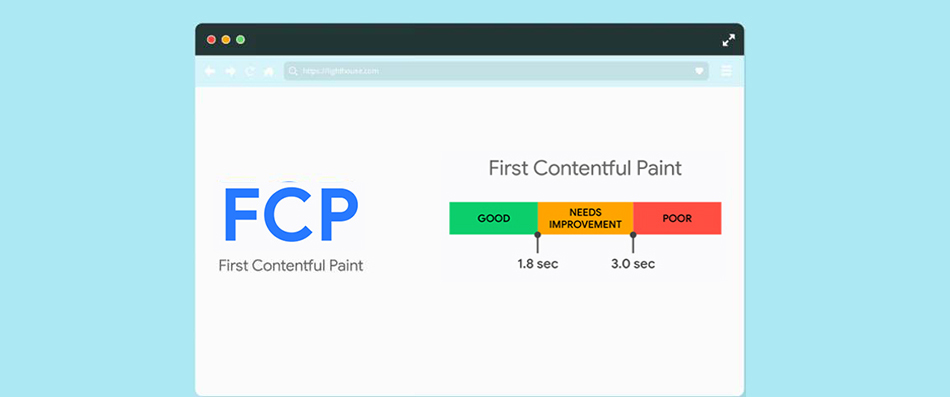
Don’t worry if your site has a low FCP score. We have combined the right First Contentful Paint (FCP) optimization techniques to fix it. You can reduce FCP time and user experience by following these simple steps:
Optimize Critical Rendering Path
CSS and JavaScript can block the rendering of useful content on the site. Keep them in line and optimized to clear the rendering path. You can use async or defer loading for non-critical scripts.
Speed Up the Text Rendering
To optimize font loading on your website, use default web fonts that load quickly. Apply preloading for the important fonts to reduce the delays.
Optimize Images and Videos
To optimize your images, use the latest formats like AVIF or WebP that compress the images without hurting the quality. Use asynchronous or lazy loading for in-line image loading.
Enhance the Server’s Response Time
Choose a reliable and fast hosting company as they provide built-in optimization features. You can use caching methods and a Content Delivery Network (CDN) to enhance FCP.
Reduce Third-Party Scripts
Defer the loading of third-party scripts as they can block the rendering of the useful content. Limit the use of tracking scripts, ads, and analytics.
Implement Preload and Prefetching Techniques
Preload fonts, CSS, or images that are important for content that is above the fold. To boost your resource and server response times, prefetch DNS requests to get resources faster.
FCP vs LCP vs CLS – Core Web Vital Metrics

FCP is an important part of the Core Web Vitals metrics that fits in with LCP and CLS to make a strong Google ranking factor.
1. FCP (First Contentful Paint): This metric measures the loading time of the first piece of content on a website, impacting the user’s first impression.
2. LCP (Largest Contentful Paint): It is the load time of the largest content or the element, like a hero image on a website, which builds users’ trust.
3. CLS (Cumulative Layout Shift): This metric measures the visual stability of a website. When a page loads, elements and layouts of the website might shift, impacting the user’s experience.
Google measures the overall website performance of a website by measuring these metrics. Together, these three metrics show the speed, interactivity, and stability of a website, which is important for a good UX. Strengthening these metrics ensures a smooth browsing experience where FCP is the first milestone to achieve.
Last Thoughts
First Contentful Paint (FCP) is more than just a speed test; it shows how quickly your website gains user trust and engagement. A low FCP score can hurt both SEO rankings and user satisfaction.
You can make your site faster and easier to navigate for the search engines by regularly checking your FCP, following optimization best practices, and keeping an eye on Core Web Vitals as a whole.
Optimizing FCP should be at the top of your list of things to do, but not the only thing, if you want your website to load quickly, rank higher, and get more visitors. Along with this, you need to improve your LCP, CLS, and INP as well.












































